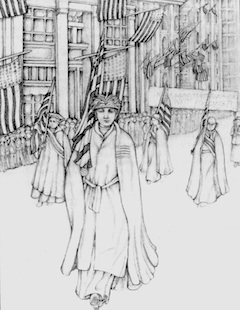|
J. William T. "Bill" Youngs, American Realities, Volume Two:
Historical Episodes from Reconstruction to the Present, Chapter Six |
"Suffrage Rally" courtesy of the Wikipedia Commons
|
6. Expanding American Democracy
|
SummaryCritics of woman suffrage predicted dire consequences if men abandoned their monopoly on politics. Women’s weak minds and delicate temperaments could not survive the hurly-burly of public life. The complexity of politics and the rough election-day crowds would either frighten women into simpering fools or transform them into unnatural amazons. Gone would be the charm and serenity of the tender sex, the woman’s capacity to create havens of domestic tranquility in a tumultuous world. With such arguments, many Americans sought to deny women the ballot. But woman suffragists said “Nonsense!” to the romantic fiction of the female incapacity for electoral politics. In a democracy, they argued, it was outrageous to leave half the citizens unrepresented because of their sex. These reformers, men as well as women, fought seventy years for woman suffrage. Their campaigns won success at the height of the Progressive Era, and yet many Progressives, while embracing other reforms, were reluctant to support woman suffrage. A woman’s right to vote would soon seem as natural as her right to live, but the change came only after a long struggle.
|
Author reads from the Text
The suffragists represented a wide gamut of political sensibilities. Some, like Bell Kearney of Mississippi, believed that woman suffrage would help maintain the superiority of America’s traditional rulers. She argued that woman suffrage with a literacy requirement would greatly increase the ratio of white to black voters in the South. The South, she said, should “look to its Anglo-Saxon women as the medium through which to retain the supremacy of the white race over the African.” Others, however, like Jane Addams and Pauline Shaw, believed that suffrage would help elevate the poorer classes.
In the early 1900s the movement gained increasing support from poorer women laborers. Caroline A. Lowe, a suffragist from Kansas City, Missouri, and a wage earner herself, presented an eloquent appeal on behalf of seven million working women to the 1912 NAWSA Convention. “From the standpoint of wages received,” she said, “we wage earners know it to be almost universal that the men in the industries receive twice the amount granted to us although we may be doing the same work. We work side by side with our brothers; we are children of the same parents, reared in the same homes, educated in the same schools, ride to and fro on the same early morning and late evening cars, work together the same number of hours in the same shop and we have equal need of food, clothing and shelter. But at 21 years of age our brothers are given a powerful weapon for self-defense, a larger means for growth and self-expression.”
In the early 1900s the movement gained increasing support from poorer women laborers. Caroline A. Lowe, a suffragist from Kansas City, Missouri, and a wage earner herself, presented an eloquent appeal on behalf of seven million working women to the 1912 NAWSA Convention. “From the standpoint of wages received,” she said, “we wage earners know it to be almost universal that the men in the industries receive twice the amount granted to us although we may be doing the same work. We work side by side with our brothers; we are children of the same parents, reared in the same homes, educated in the same schools, ride to and fro on the same early morning and late evening cars, work together the same number of hours in the same shop and we have equal need of food, clothing and shelter. But at 21 years of age our brothers are given a powerful weapon for self-defense, a larger means for growth and self-expression.”
Links

